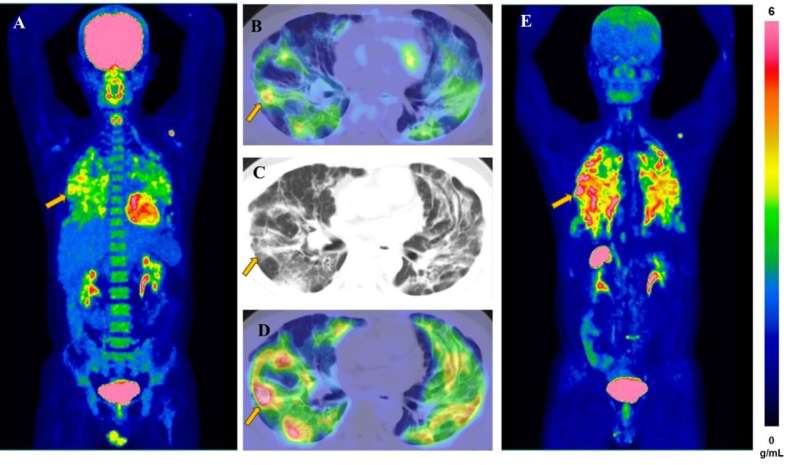This article has been reviewed according to Science X's editorial process and policies. Editors have highlighted the following attributes while ensuring the content's credibility:
fact-checked
peer-reviewed publication
proofread
Study says FAPI PET/CT bests FDG in predicting progressive lung disease

In a head-to-head study, FAPI PET/CT was found to be more predictive of progressive pulmonary fibrosis in interstitial lung disease (ILD) patients than 18F-FDG PET/CT. With heightened and extensive uptake compared to 18F-FDG, FAPI PET/CT can play an important role in identifying patients who should be monitored closely or begin preventive treatment. This research was presented at the 2024 Society of Nuclear Medicine and Molecular Imaging Annual Meeting.
ILD encompasses a spectrum of disorders characterized by pulmonary alveolitis and interstitial fibrosis, comprising over 200 specific diseases. Most ILDs, despite regular treatment, manifest progressive pulmonary fibrosis which can lead to heightened mortality. Early diagnosis of progressive pulmonary fibrosis is pivotal for prognosis; however, conventional imaging methods offer limited assistance in the early stages.
"While 18F-FDG PET/CT can offer some information about ILDs, FAPI PET/CT could provide even more information to physicians, especially regarding progressive pulmonary fibrosis. This could make it a promising diagnostic tool," noted Qi Fang, student in resident training in the Department of Nuclear Medicine at Guangzhou Medical University in Guangzhou, China. "In our study we aimed to evaluate the efficacy of 18F-FDG and FAPI PET/CT in ILD patients and determine their respective diagnostic value."
Ninety-seven ILD patients received both 18F-FDG and FAPI PET/CT within one week. Various PET/CT parameters were assessed and pulmonary function test results within two months of PET/CT were documented. CT, pulmonary function tests, and clinical symptom assessment were collected after one year to differentiate between patients with did and did not have progressive pulmonary fibrosis.
All PET/CT parameters in FAPI PET/CT were significantly higher than the corresponding ones in 18F-FDG PET/CT. In addition, all FAPI PET/CT parameters in progressive pulmonary fibrosis patients were markedly higher than those in non-progressive pulmonary fibrosis patients. Of the various parameters, the whole-lung SUVmean emerged as an especially notable factor for predicting progressive pulmonary fibrosis in ILD patients.
"These findings underscore the potential utility of FAPI PET/CT as an imaging modality for diagnosing ILD," said Fang. "In particular, our research shows that patients with high whole-lung SUVmean on FAPI scans tend to manifest progressive pulmonary fibrosis one year later. As such, these patients should be more carefully treated, and anti-fibrosis treatment should begin as early as possible."
More information: Abstract 241401: Fang et al. Comparative Analysis of FDG and FAPI PET/CT Imaging in Interstitial Lung Disease: Focused on Progressive Pulmonary Fibrosis Prediction, Journal of Nuclear Medicine (2024).


















